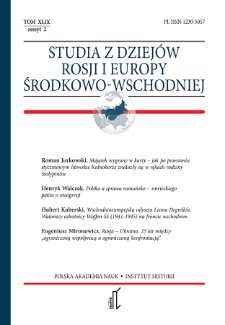
Object
Title: Pomoc Jointu i Agro-Jointu dla ludności żydowskiej na obszarze Białorusi radzieckiej
Subtitle:
Studia z Dziejów Rosji i Europy Środkowo-Wschodniej T. 49 z. 2 (2014)
Contributor:
Institute of History of the Polish Academy of Sciences
Publisher:
Place of publishing:
Description:
p. 51-73 ; Summary in English and Russian. ; Author's name: Ewa Kowalska-Dąbrowska.
Type of object:
Abstract:
The Soviet state that emerged after 1917 became the heir of the Russian Empire and its geopolitical situation, which the Bolsheviks intended to preserve and consolidate in order for different communities to adopt one common Soviet system of values, norms and opinions. The resettlement of the Jewish community into rural areas was one of the aspects of the eth-nic integration policies. The operation, launched by the Central Committee of the RCP(b) in 1924, aimed to facilitate the formation of a peasant stratum in the Jewish society, which would transform its culture in a way to merge the Jews with the multinational population of the USSR. Considering the lack of state funds, the implementation of the top-down plan was made possi-ble by financial aid from external sources, the American organisation Agro-Joint in particular.
References:
1. Chenkin E. M., Oczerki istorii borby sovietskogo gosudarstva s gołodom (1921–1922 gg), Krasnojarsk 1988.
2. Chenkin E. M., O roli „Dżonta” w okazanii pomoszczi Rossii i Ukraine v 1921–23 rr., „Vestnik Evrejskogo universiteta w Moskve”, no. 4, 1993.
3. Edmondson Ch. M., An Inquiry into the Termination of Soviet Famine Relief Programmes and the Renewal of Grain Export, 1922–23, „Soviet Studies”, Vol. 33, No. 3 (1981).
4. Fisher H., The Famine in Soviet Russia: 1921–1923. The Operations of the American Relief Administration, New York, Macmilan, 1927.
5. Gierowska–Kałłaur J., Polacy i Białorusini we wzajemnych opiniach w latach 1918–1921, „Studia z Dziejów Rosji i Europy Środkowo–Wschodniej”, 42, 2007.
6. Gierowska-Kałłaur, J., Straż Kresowa wobec kwestii białoruskiej. Deklaracje i praktyka, „Studia z Dziejów Rosji i Europy Środkowo–Wschodniej”, 44, 2009.
7. Gierowska-Kałłaur, J., Aktywność środowisk polskich w Mińszczyźnie w realiach lat 1919–1920, „Studia z Dziejów Rosji i Europy Środkowo–Wschodniej”, 45, 2010.
8. Golde J. W., Zemelnoe ustrojstwo trudjaszczichsja evreev, Moskva 1925.
9. Gurevicz M. B., Gołod i selskoe chozjajstvo Ukrainy, Charkov 1923.
10. Ivnickij N. A., Repressivnaja polityka sovietskoj vłasti v derevne (1928–1933), Moskva 2000
11. Joffe E., Mielcer B., Dżoint v Biełorusi, Minsk 1999.
12. Kalinin M., Ob. Obrazovaniji Jevriejskoj avtonomnoj obłastii, Moskva 1935.
13. Kostikov V., The People and Land Borobidzhan, Moskow 1979.
14. Lepecki M., Birobidżan Żydowski Obwód Autonomiczny w ZSRR, Warszawa 1937.
15. Micel M., Posleniaja głava. Agro–Dżojnt v gody Bolszogo tierrora, Kiiv 2012.
16. Patek A., Birobidżan Sowiecka ziemia obiecana?, Kraków 1997.
17. Privałova T. V., Byt rossijskoj derevni 60–e gody XIX–20–e gody XX w., Moskva 2000.
18. Sbornik statej po evriejskoj istorii i literaturze, t. 2, cz. 1, Israel 1992.
19. Serbin R., Gołod 1921–1923 i ukrainska presa v Kanadi, Toronto 1992.
Relation:
Studia z Dziejów Rosji i Europy Środkowo-Wschodniej
Volume:
Issue:
Start page:
End page:
Detailed Resource Type:
Format:
Resource Identifier:
oai:rcin.org.pl:52303 ; 1230-5057
Source:
IH PAN, sygn. A.453/49/2 Podr. ; IH PAN, sygn. A.454/49/2 ; click here to follow the link
Language:
Language of abstract:
Rights:
Terms of use:
Copyright-protected material. May be used within the limits of statutory user freedoms
Digitizing institution:
Institute of History of the Polish Academy of Sciences
Original in:
Library of the Institute of History PAS
Projects co-financed by:
Access:
Object collections:
- Digital Repository of Scientific Institutes > Partners' collections > Institute of History PAS > Serials
- Digital Repository of Scientific Institutes > Partners' collections > Institute of History PAS > Institute Publications
- Digital Repository of Scientific Institutes > Partners' collections > Institute of History PAS > Institute Publications > Journals
- Digital Repository of Scientific Institutes > Partners' collections > Institute of History PAS > Institute Publications > Journals > Studia z Dziejów Rosji i Europy Środkowo-Wschodniej
- Digital Repository of Scientific Institutes > Literature > Journals/Articles
Last modified:
Sep 22, 2023
In our library since:
Mar 10, 2015
Number of object content downloads / hits:
719
All available object's versions:
https://rcin.org.pl./publication/71655
Show description in RDF format:
Show description in RDFa format:
Show description in OAI-PMH format:
| Edition name | Date |
|---|---|
| Kowalska, Ewa (historia), Pomoc Jointu i Agro-Jointu dla ludności żydowskiej na obszarze Białorusi radzieckiej | Sep 22, 2023 |
Objects Similar
Kowalska, Ewa
Micel', Mihail (1953– )
Bańkowska, Aleksandra (1980– )
Kowalska Ewa
Kowalska Ewa
Kowalska, Ewa
Kowalska, Ewa
Kowalska, Ewa

 INSTYTUT ARCHEOLOGII I ETNOLOGII POLSKIEJ AKADEMII NAUK
INSTYTUT ARCHEOLOGII I ETNOLOGII POLSKIEJ AKADEMII NAUK
 INSTYTUT BADAŃ LITERACKICH POLSKIEJ AKADEMII NAUK
INSTYTUT BADAŃ LITERACKICH POLSKIEJ AKADEMII NAUK
 INSTYTUT BADAWCZY LEŚNICTWA
INSTYTUT BADAWCZY LEŚNICTWA
 INSTYTUT BIOLOGII DOŚWIADCZALNEJ IM. MARCELEGO NENCKIEGO POLSKIEJ AKADEMII NAUK
INSTYTUT BIOLOGII DOŚWIADCZALNEJ IM. MARCELEGO NENCKIEGO POLSKIEJ AKADEMII NAUK
 INSTYTUT BIOLOGII SSAKÓW POLSKIEJ AKADEMII NAUK
INSTYTUT BIOLOGII SSAKÓW POLSKIEJ AKADEMII NAUK
 INSTYTUT CHEMII FIZYCZNEJ PAN
INSTYTUT CHEMII FIZYCZNEJ PAN
 INSTYTUT CHEMII ORGANICZNEJ PAN
INSTYTUT CHEMII ORGANICZNEJ PAN
 INSTYTUT FILOZOFII I SOCJOLOGII PAN
INSTYTUT FILOZOFII I SOCJOLOGII PAN
 INSTYTUT GEOGRAFII I PRZESTRZENNEGO ZAGOSPODAROWANIA PAN
INSTYTUT GEOGRAFII I PRZESTRZENNEGO ZAGOSPODAROWANIA PAN
 INSTYTUT HISTORII im. TADEUSZA MANTEUFFLA POLSKIEJ AKADEMII NAUK
INSTYTUT HISTORII im. TADEUSZA MANTEUFFLA POLSKIEJ AKADEMII NAUK
 INSTYTUT JĘZYKA POLSKIEGO POLSKIEJ AKADEMII NAUK
INSTYTUT JĘZYKA POLSKIEGO POLSKIEJ AKADEMII NAUK
 INSTYTUT MATEMATYCZNY PAN
INSTYTUT MATEMATYCZNY PAN
 INSTYTUT MEDYCYNY DOŚWIADCZALNEJ I KLINICZNEJ IM.MIROSŁAWA MOSSAKOWSKIEGO POLSKIEJ AKADEMII NAUK
INSTYTUT MEDYCYNY DOŚWIADCZALNEJ I KLINICZNEJ IM.MIROSŁAWA MOSSAKOWSKIEGO POLSKIEJ AKADEMII NAUK
 INSTYTUT PODSTAWOWYCH PROBLEMÓW TECHNIKI PAN
INSTYTUT PODSTAWOWYCH PROBLEMÓW TECHNIKI PAN
 INSTYTUT SLAWISTYKI PAN
INSTYTUT SLAWISTYKI PAN
 SIEĆ BADAWCZA ŁUKASIEWICZ - INSTYTUT TECHNOLOGII MATERIAŁÓW ELEKTRONICZNYCH
SIEĆ BADAWCZA ŁUKASIEWICZ - INSTYTUT TECHNOLOGII MATERIAŁÓW ELEKTRONICZNYCH
 MUZEUM I INSTYTUT ZOOLOGII POLSKIEJ AKADEMII NAUK
MUZEUM I INSTYTUT ZOOLOGII POLSKIEJ AKADEMII NAUK
 INSTYTUT BADAŃ SYSTEMOWYCH PAN
INSTYTUT BADAŃ SYSTEMOWYCH PAN
 INSTYTUT BOTANIKI IM. WŁADYSŁAWA SZAFERA POLSKIEJ AKADEMII NAUK
INSTYTUT BOTANIKI IM. WŁADYSŁAWA SZAFERA POLSKIEJ AKADEMII NAUK


































